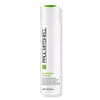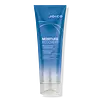What's inside
What's inside
 Key Ingredients
Key Ingredients

No key ingredients
 Benefits
Benefits

 Concerns
Concerns

 Ingredients Side-by-side
Ingredients Side-by-side

Water
Skin ConditioningCetyl Alcohol
EmollientCetearyl Alcohol
EmollientQuaternium-91
Cetrimonium Methosulfate
AntimicrobialAmodimethicone
Cetyl Esters
EmollientAlgae Extract
EmollientAloe Barbadensis Extract
Skin ConditioningAnthemis Nobilis Flower Extract
MaskingRosmarinus Officinalis Leaf
Skin ConditioningSimmondsia Chinensis Seed Oil
EmollientHydrolyzed Wheat Protein Pg-Propyl Silanetriol
Skin ConditioningAcetic Acid
BufferingAlcohol
AntimicrobialBisamino PEG/PPG-41/3 Aminoethyl Pg-Propyl Dimethicone
C11-15 Pareth-7
EmulsifyingC12-16 Pareth-9
EmulsifyingCetrimonium Chloride
AntimicrobialCitric Acid
BufferingDimethicone
EmollientGlycerin
HumectantGuar Hydroxypropyltrimonium Chloride
Skin ConditioningMagnesium Chloride
Magnesium Nitrate
Olealkonium Chloride
PEG-12 Dimethicone
Skin ConditioningPolyquaternium-37
Polysorbate 60
EmulsifyingPPG-1 Trideceth-6
Skin ConditioningPropylene Glycol Dicaprylate/Dicaprate
EmollientTetrasodium EDTA
Tribehenin
EmollientTrideceth-12
EmulsifyingTrideceth-15
EmulsifyingTrideceth-3
EmulsifyingTriethyl Citrate
MaskingTrimethylsiloxyamodimethicone
Methylchloroisothiazolinone
PreservativeMethylisothiazolinone
PreservativePhenoxyethanol
PreservativeParfum
MaskingHexyl Cinnamal
PerfumingLinalool
PerfumingWater, Cetyl Alcohol, Cetearyl Alcohol, Quaternium-91, Cetrimonium Methosulfate, Amodimethicone, Cetyl Esters, Algae Extract, Aloe Barbadensis Extract, Anthemis Nobilis Flower Extract, Rosmarinus Officinalis Leaf, Simmondsia Chinensis Seed Oil, Hydrolyzed Wheat Protein Pg-Propyl Silanetriol, Acetic Acid, Alcohol, Bisamino PEG/PPG-41/3 Aminoethyl Pg-Propyl Dimethicone, C11-15 Pareth-7, C12-16 Pareth-9, Cetrimonium Chloride, Citric Acid, Dimethicone, Glycerin, Guar Hydroxypropyltrimonium Chloride, Magnesium Chloride, Magnesium Nitrate, Olealkonium Chloride, PEG-12 Dimethicone, Polyquaternium-37, Polysorbate 60, PPG-1 Trideceth-6, Propylene Glycol Dicaprylate/Dicaprate, Tetrasodium EDTA, Tribehenin, Trideceth-12, Trideceth-15, Trideceth-3, Triethyl Citrate, Trimethylsiloxyamodimethicone, Methylchloroisothiazolinone, Methylisothiazolinone, Phenoxyethanol, Parfum, Hexyl Cinnamal, Linalool
Water
Skin ConditioningCetearyl Alcohol
EmollientDimethicone
EmollientSorbitol
HumectantPropylene Glycol
HumectantBehentrimonium Chloride
PreservativeStearyl Alcohol
EmollientPhenoxyethanol
PreservativeCocos Nucifera Oil
MaskingRosa Canina Fruit Oil
EmollientLaurdimonium Hydroxypropyl Hydrolyzed Keratin
Skin ConditioningSimmondsia Chinensis Seed Oil
EmollientChlorella Vulgaris Extract
Skin ConditioningSea Water
HumectantHydrolyzed Algin
Arginine Hcl
Skin ConditioningPhosphatidylcholine
EmulsifyingIsopropyl Palmitate
EmollientCetyl Esters
EmollientHydroxyethylcellulose
Emulsion StabilisingCetrimonium Chloride
AntimicrobialGuar Hydroxypropyltrimonium Chloride
Skin ConditioningPolyquaternium-37
Aminopropyl Dimethicone
Tetrasodium Glutamate Diacetate
Propylene Glycol Dicaprylate/Dicaprate
EmollientPEG-4 Laurate
EmulsifyingCitric Acid
BufferingPEG-90m
Emulsion StabilisingPPG-1 Trideceth-6
Skin ConditioningIodopropynyl Butylcarbamate
PreservativeSodium Hydroxide
BufferingIsopropyl Alcohol
SolventLimonene
PerfumingBenzyl Benzoate
AntimicrobialParfum
MaskingCI 60730
Cosmetic ColorantCI 42090
Cosmetic ColorantCI 19140
Cosmetic ColorantWater, Cetearyl Alcohol, Dimethicone, Sorbitol, Propylene Glycol, Behentrimonium Chloride, Stearyl Alcohol, Phenoxyethanol, Cocos Nucifera Oil, Rosa Canina Fruit Oil, Laurdimonium Hydroxypropyl Hydrolyzed Keratin, Simmondsia Chinensis Seed Oil, Chlorella Vulgaris Extract, Sea Water, Hydrolyzed Algin, Arginine Hcl, Phosphatidylcholine, Isopropyl Palmitate, Cetyl Esters, Hydroxyethylcellulose, Cetrimonium Chloride, Guar Hydroxypropyltrimonium Chloride, Polyquaternium-37, Aminopropyl Dimethicone, Tetrasodium Glutamate Diacetate, Propylene Glycol Dicaprylate/Dicaprate, PEG-4 Laurate, Citric Acid, PEG-90m, PPG-1 Trideceth-6, Iodopropynyl Butylcarbamate, Sodium Hydroxide, Isopropyl Alcohol, Limonene, Benzyl Benzoate, Parfum, CI 60730, CI 42090, CI 19140
Ingredients Explained
These ingredients are found in both products.
Ingredients higher up in an ingredient list are typically present in a larger amount.
Cetearyl alcohol is a mixture of two fatty alcohols: cetyl alcohol and stearyl alcohol. It is mainly used as an emulsifier. Emulsifiers help prevent the separation of oils and products. Due to its composition, it can also be used to thicken a product or help create foam.
Cetearyl alcohol is an emollient. Emollients help soothe and hydrate the skin by trapping moisture.
Studies show Cetearyl alcohol is non-toxic and non-irritating. The FDA allows products labeled "alcohol-free" to have fatty alcohols.
This ingredient is usually derived from plant oils such as palm, vegetable, or coconut oils. There is debate on whether this ingredient will cause acne.
Due to the fatty acid base, this ingredient may not be Malassezia folliculitis safe.
Learn more about Cetearyl AlcoholThis ingredient is a preservative, antimicrobial, and emulsifier. It is often used in cosmetics for its ability to cleanse, condition, and reduce static.
Cetrimonium chloride is a quaternary ammonium salt, meaning it has a water-soluble structure.
Cetyl Esters is a synthetic wax made up of mostly fatty acids and fatty alcohols. It is strcturally similar to wax taken from whales.
As an emollient, it creates a thin barrier on the skin. This barrier prevents moisture from escaping.
This ingredient may not be fungal-acne safe.
Learn more about Cetyl EstersCitric Acid is an alpha hydroxy acid (AHA) naturally found in citrus fruits like oranges, lemons, and limes.
Like other AHAs, citric acid can exfoliate skin by breaking down the bonds that hold dead skin cells together. This helps reveal smoother and brighter skin underneath.
However, this exfoliating effect only happens at high concentrations (20%) which can be hard to find in cosmetic products.
Due to this, citric acid is usually included in small amounts as a pH adjuster. This helps keep products slightly more acidic and compatible with skin's natural pH.
In skincare formulas, citric acid can:
While it can provide some skin benefits, research shows lactic acid and glycolic acid are generally more effective and less irritating exfoliants.
Most citric acid used in skincare today is made by fermenting sugars (usually from molasses). This synthetic version is identical to the natural citrus form but easier to stabilize and use in formulations.
Read more about some other popular AHA's here:
Learn more about Citric AcidDimethicone is a type of synthetic silicone created from natural materials such as quartz.
What it does:
Dimethicone comes in different viscosities:
Depending on the viscosity, dimethicone has different properties.
Ingredients lists don't always show which type is used, so we recommend reaching out to the brand if you have questions about the viscosity.
This ingredient is unlikely to cause irritation because it does not get absorbed into skin. However, people with silicone allergies should be careful about using this ingredient.
Note: Dimethicone may contribute to pilling. This is because it is not oil or water soluble, so pilling may occur when layered with products. When mixed with heavy oils in a formula, the outcome is also quite greasy.
Learn more about DimethiconeThis ingredient is derived from guar gum.
It is a conditioning ingredient, meaning it helps soften skin and hair.
Parfum is a catch-all term for an ingredient or more that is used to give a scent to products.
Also called "fragrance", this ingredient can be a blend of hundreds of chemicals or plant oils. This means every product with "fragrance" or "parfum" in the ingredients list is a different mixture.
For instance, Habanolide is a proprietary trade name for a specific aroma chemical. When used as a fragrance ingredient in cosmetics, most aroma chemicals fall under the broad labeling category of “FRAGRANCE” or “PARFUM” according to EU and US regulations.
The term 'parfum' or 'fragrance' is not regulated in many countries. In many cases, it is up to the brand to define this term.
For instance, many brands choose to label themselves as "fragrance-free" because they are not using synthetic fragrances. However, their products may still contain ingredients such as essential oils that are considered a fragrance by INCI standards.
One example is Calendula flower extract. Calendula is an essential oil that still imparts a scent or 'fragrance'.
Depending on the blend, the ingredients in the mixture can cause allergies and sensitivities on the skin. Some ingredients that are known EU allergens include linalool and citronellol.
Parfum can also be used to mask or cover an unpleasant scent.
The bottom line is: not all fragrances/parfum/ingredients are created equally. If you are worried about fragrances, we recommend taking a closer look at an ingredient. And of course, we always recommend speaking with a professional.
Learn more about ParfumPhenoxyethanol is a preservative that has germicide, antimicrobial, and aromatic properties. Studies show that phenoxyethanol can prevent microbial growth. By itself, it has a scent that is similar to that of a rose.
It's often used in formulations along with Caprylyl Glycol to preserve the shelf life of products.
We don't have a description for Polyquaternium-37 yet.
We don't have a description for PPG-1 Trideceth-6 yet.
Propylene Glycol Dicaprylate/Dicaprate is a mixture of Propylene Glycol Dicaprylate and Propylene Glycol Dicaprate.
It is an emollient and helps hydate the skin.
This oil comes from the seeds of the desert shrub called Jojoba. It is more commonly known as jojoba oil, a non-comedogenic oil.
Jojoba oil does not contain fragrance and has many fatty-acids, making it a great soothing ingredient.
It also contains Vitamin E, a great moisturizing ingredient. Vitamin E is also an antioxidant and protects your skin against oxidative damage.
This ingredient humectant properties, meaning it helps draw moisture from the air. This helps keep your skin hydrated.
While jojoba has antibacterial properties, it is only able to kill some strains of bacteria.
Studies also show it helps in wound healing. In fact, Indigenous cultures have used jojoba as a moisturizer and to help treat burns for centuries.
Fun fact: Jojoba oil similar to natural human skin sebum, so it has a great effect on dry skin. It is also promising with helping to regulate sebum production.
Due to its fatty acid content, Jojoba oil may not be fungal acne safe. We recommend speaking with a professional if you have any concerns.
Learn more about Simmondsia Chinensis Seed OilWater. It's the most common cosmetic ingredient of all. You'll usually see it at the top of ingredient lists, meaning that it makes up the largest part of the product.
So why is it so popular? Water most often acts as a solvent - this means that it helps dissolve other ingredients into the formulation.
You'll also recognize water as that liquid we all need to stay alive. If you see this, drink a glass of water. Stay hydrated!
Learn more about Water